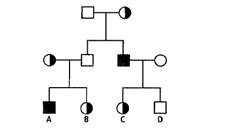
Concept explainers
To describe:
The inheritance pattern of the disease in the given pedigree
Introduction:
Genetic disorders result from inheritance of traits which are either dominant or recessive. The basic patterns of human inheritance follow
Answer to Problem 17STP
The pedigree given below is an example of X linked recessive inheritance in which females are carriers of the trait/ disorder but do not express it while males may or may not carry the trait. If males carry the trait, they will express it.
Example of such an inheritance pattern is hemophilia.
Explanation of Solution
Traits that are controlled by genes located on sex chromosomes; X chromosomes in particular are called sex- linked traits or X- linked traits. Since males have only X chromosome, they are affected by recessive X- linked traits more often than females. Females usually do not express the recessive trait as other X chromosome will mask the effect of the recessive trait.
The pedigree given below is an example of X linked recessive inheritance.

According to the given pedigree, father does not carry the trait but mother is a carrier of the trait. In the first generation, one son carries the gene while another one does not carry the gene. In the second generation, daughters carry the gene and sons may or may not carry the gene.
When a mother is a carrier of the gene,
- There is 50% chance that daughters will carry the gene and transfer it to next generation.
- There is 50% chance that a daughter will not carry the gene and therefore cannot transfer it to next generation.
- There is 50% chance that sons will also carry the gene and express it.
- There is 50% chance that sons will not carry the gene and will remain healthy.
There is no transmission of trait/ disorder from male to male.
Chapter 12 Solutions
Glencoe Biology (Glencoe Science)
Additional Science Textbook Solutions
Campbell Biology: Concepts & Connections (9th Edition)
Campbell Biology (11th Edition)
Chemistry & Chemical Reactivity
Organic Chemistry (8th Edition)
Chemistry: A Molecular Approach (4th Edition)
Introductory Chemistry (6th Edition)
- Explain how the hormones of the glands listed below travel around the body to target organs and tissues : Pituitary gland Hypothalamus Thyroid Parathyroid Adrenal Pineal Pancreas(islets of langerhans) Gonads (testes and ovaries) Placentaarrow_forwardWhat are the functions of the hormones produced in the glands listed below: Pituitary gland Hypothalamus Thyroid Parathyroid Adrenal Pineal Pancreas(islets of langerhans) Gonads (testes and ovaries) Placentaarrow_forwardDescribe the hormones produced in the glands listed below: Pituitary gland Hypothalamus Thyroid Parathyroid Adrenal Pineal Pancreas(islets of langerhans) Gonads (testes and ovaries) Placentaarrow_forward
- Please help me calculate drug dosage from the following information: Patient weight: 35 pounds, so 15.9 kilograms (got this by dividing 35 pounds by 2.2 kilograms) Drug dose: 0.05mg/kg Drug concentration: 2mg/mLarrow_forwardA 25-year-old woman presents to the emergency department with a 2-day history of fever, chills, severe headache, and confusion. She recently returned from a trip to sub-Saharan Africa, where she did not take malaria prophylaxis. On examination, she is febrile (39.8°C/103.6°F) and hypotensive. Laboratory studies reveal hemoglobin of 8.0 g/dL, platelet count of 50,000/μL, and evidence of hemoglobinuria. A peripheral blood smear shows ring forms and banana-shaped gametocytes. Which of the following Plasmodium species is most likely responsible for her severe symptoms? A. Plasmodium vivax B. Plasmodium ovale C. Plasmodium malariae D. Plasmodium falciparumarrow_forwardStandard Concentration (caffeine) mg/L Absorbance Reading 10 0.322 20 0.697 40 1.535 60 2.520 80 3.100arrow_forward
 Human Anatomy & Physiology (11th Edition)BiologyISBN:9780134580999Author:Elaine N. Marieb, Katja N. HoehnPublisher:PEARSON
Human Anatomy & Physiology (11th Edition)BiologyISBN:9780134580999Author:Elaine N. Marieb, Katja N. HoehnPublisher:PEARSON Biology 2eBiologyISBN:9781947172517Author:Matthew Douglas, Jung Choi, Mary Ann ClarkPublisher:OpenStax
Biology 2eBiologyISBN:9781947172517Author:Matthew Douglas, Jung Choi, Mary Ann ClarkPublisher:OpenStax Anatomy & PhysiologyBiologyISBN:9781259398629Author:McKinley, Michael P., O'loughlin, Valerie Dean, Bidle, Theresa StouterPublisher:Mcgraw Hill Education,
Anatomy & PhysiologyBiologyISBN:9781259398629Author:McKinley, Michael P., O'loughlin, Valerie Dean, Bidle, Theresa StouterPublisher:Mcgraw Hill Education, Molecular Biology of the Cell (Sixth Edition)BiologyISBN:9780815344322Author:Bruce Alberts, Alexander D. Johnson, Julian Lewis, David Morgan, Martin Raff, Keith Roberts, Peter WalterPublisher:W. W. Norton & Company
Molecular Biology of the Cell (Sixth Edition)BiologyISBN:9780815344322Author:Bruce Alberts, Alexander D. Johnson, Julian Lewis, David Morgan, Martin Raff, Keith Roberts, Peter WalterPublisher:W. W. Norton & Company Laboratory Manual For Human Anatomy & PhysiologyBiologyISBN:9781260159363Author:Martin, Terry R., Prentice-craver, CynthiaPublisher:McGraw-Hill Publishing Co.
Laboratory Manual For Human Anatomy & PhysiologyBiologyISBN:9781260159363Author:Martin, Terry R., Prentice-craver, CynthiaPublisher:McGraw-Hill Publishing Co. Inquiry Into Life (16th Edition)BiologyISBN:9781260231700Author:Sylvia S. Mader, Michael WindelspechtPublisher:McGraw Hill Education
Inquiry Into Life (16th Edition)BiologyISBN:9781260231700Author:Sylvia S. Mader, Michael WindelspechtPublisher:McGraw Hill Education





